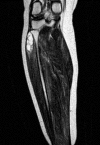Compression of common peroneal nerve caused by an extraneural ganglion cyst mimicking intermittent claudication
- PMID: 23721086
- PMCID: PMC3707792
- DOI: 10.1186/1749-7221-8-5
Compression of common peroneal nerve caused by an extraneural ganglion cyst mimicking intermittent claudication
Abstract
Peripheral neuropathies caused by ganglion cysts are rare. They seldom cause serious complications especially in the lower extremities. The case was a 51-year-old woman referred by her physician to the vascular surgeon with diagnosis including intermittent (vascular) claudication and deep venous thrombosis. Primarily vascular surgeon performed a doppler ultrasound of the lower extremity and calculation of the ankle-brachial index. There were no abnormal pathological findings. Careful physical examination revealed soft swelling and tenderness around the fibular head and neck. Weakness was observed in foot eversion and dorsiflexion. There was pain and tingling in the distribution of the peroneal nerve. and referring the patient to orthopedic surgeon owing to concern for a potential compressive lesion at the right proximal tibiofibular region. Electromyogram studies and physical examination confirmed a diagnosis of compression neuropathy of common peroneal nerve. Magnetic resonance imaging revealed a fluid-filled, lobulated mass indicating a ganglion cyst. One months after decompression, the patient had no complaint. Fast diagnosis and immediate management are essential to regain best possible recovery.
Figures
References
-
- Frank DA, Sangimino MJ. Peroneal nerve palsy secondary to ganglion cyst of the proximal tibiofibular joint in a pediatric patient. Orthopedics. 2008;8:86. - PubMed
Publication types
LinkOut - more resources
Full Text Sources
Other Literature Sources



